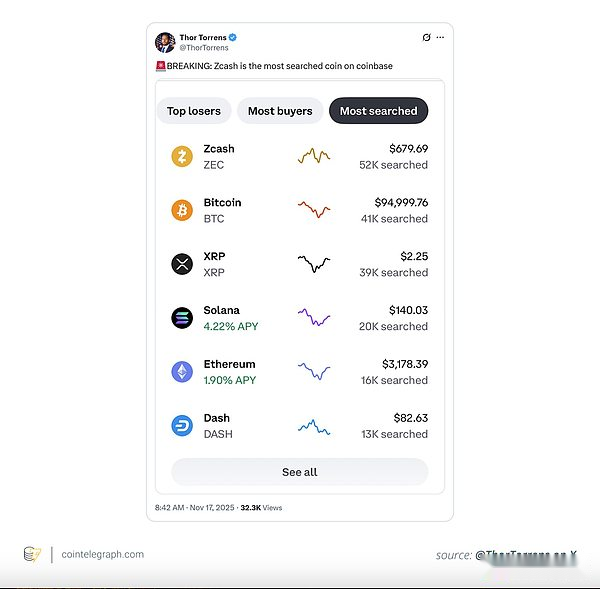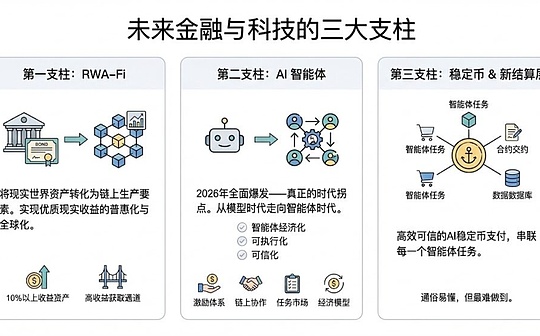
Author: Bradley Peak, Source: Cointelegraph, Compiler: Shaw Bitcoin Vision
Summary of key points
-
The price of privacy coins such as Zcash has increased, while the total market value of cryptocurrencies and the price of Bitcoin have declined significantly.
-
The rally comes against a backdrop of tightening policies, including pressure from the Financial Action Task Force (FATF), new EU anti-money laundering rules and a growing number of privacy coins being delisted.
-
Sanctions cases and prosecutions involving mixers and wallets have raised questions about the lines between infrastructure and funds transfer, prompting compliance teams to take cautious de-risking measures.
-
Analysts are divided on seeing this as a protest trade against surveillance, to a late-stage surge in fragility at a time when riskier areas of the market are shrinking.
Cryptocurrency markets have lost more than $1 trillion in value over the past six weeks, with traders dumping speculative assets.Total market capitalization fell from a peak of more than $4.3 trillion in early October to just over $3.1 trillion, a decrease of approximately 25%-28%.
Bitcoin prices are down nearly 30% from the all-time high of over $126,000 set in early October and are currently trading in the early $90,000s.
Against this backdrop, one of the strongest performing areas is also the most volatile category: privacy coins.
Since late summer, the price of Zcash has increased hundreds of times, with the market capitalization soaring from less than $1 billion in August to over $7 billion in early November.It once surpassed Monero and became the privacy coin with the highest market value.
At the same time, Zcash quickly climbed to the top of Coinbase’s internal search rankings, with user searches surpassing Bitcoin and XRP, indicating that retail investors’ attention has also increased.

Analysts said the combined effect of soaring prices and surging search volume foreshadowed a typical hot deal.But the complication is that this is happening in a market segment facing increasing regulatory pressure, exchange delistings and sanctions-related scrutiny.
Privacy coins as outliers: data and narrative
The latest rally has been clearly led by Zcash (ZEC), with Monero (XMR) lagging far behind.
Key figures noted by analysts include:
-
On some major trading platforms, ZEC has gained more than 200% in a month.
-
From its late summer lows, ZEC’s point-to-point moves have seen high triple-digit percentage gains.
-
XMR also rose, but the increase was much smaller than that of ZEC, which caused ZEC’s market value to briefly exceed XMR.
-
Despite the rally, ZEC is still trading well below its all-time highs.
Explanations can be roughly divided into two broad categories:
-
One category focuses on structural and technical aspects, including reduced issuance as the halving process progresses and the planned NU6.1 upgrade, which transfers more control of funds to token holders.
-
The other points to narratives and market structure, including inflated investor expectations for price, regulatory concerns, thin order books, and a short squeeze in a relatively small segment of the market.
Most observers agree that the rally comes at a time when regulatory and policy winds are turning against anonymous assets.
Regulation is moving in the opposite direction
On a global level, privacy coins are squarely in the anti-money laundering (AML) discussion.
Since 2019, the Financial Action Task Force (FATF) has applied all of its anti-money laundering and counter-terrorism financing (CFT) standards to virtual assets and virtual asset service providers (VASPs), including the Travel Rule requiring sender and recipient information to accompany eligible transfers.
A targeted update in 2024 found that about three quarters of assessed jurisdictions were still only partially or fully non-compliant with Recommendation 15, and about 30% had not yet legally implemented travel rules.The FATF also singled out the increasing use of cryptocurrencies by illicit actors that enhance anonymity as worrying.
In Europe, the direction of development is clearer.New EU-wide anti-money laundering rules centered on Regulation 2024/1624 and related legislation will prohibit the use of anonymous cryptocurrency accounts and privacy coins on licensed platforms by 2027, according to legal and policy analysis.
Cryptoasset service providers will be required to implement bank-style anti-money laundering controls, verify the beneficial owners behind wallets that interact with their services, and phase out support for fully anonymous tools.
But that doesn’t mean holding these assets is illegal everywhere.But it does mean that in much of the regulated financial system, the infrastructure is being redesigned on the premise that privacy tokens will be restricted or excluded.
Delisting, shrinking trading venues and liquidity risks
The regulatory environment has begun to reshape where and how privacy coins are traded.
Key changes:
-
In 2024, the number of privacy coins delisted from centralized exchanges is close to 60, which is the highest number since 2021.
-
Monero saw the largest number of removals, with Dash (DASH) and a number of other cryptocurrencies also affected as the exchange revisited its anti-money laundering policies.
-
Binance has restricted or canceled transactions for XMR, ZEC and DASH by users in multiple European jurisdictions, citing local regulations and compliance.
-
Kraken announced at the end of 2024 that it would cease XMR trading and deposit services for European Economic Area (EEA) customers, with a withdrawal deadline of the end of the year, and explicitly mentioned EU regulatory changes, including the Market for Crypto-Assets (MiCA) framework.
These moves could create classic liquidity dilemmas.During market rallies, thinly traded markets can move wildly on relatively small inflows.As trading moves from large, well-funded platforms to smaller or less regulated platforms, it will become more difficult for large holders to exit the market without causing price volatility.The same structure can both trigger a sudden spike and increase the risk of a price “vacuum” during a market decline.
Sanctions Spillover, Court Litigation and Compliance Anxiety
Sanctions and enforcement actions add another layer of uncertainty.
In 2022, the U.S. Treasury Department’s Office of Foreign Assets Control (OFAC) imposed sanctions on Tornado Cash, accusing the Ethereum-based mixer of laundering billions of dollars.In late 2024, a U.S. appeals court ruled that sanctioning immutable smart contracts exceeded the authority of the Treasury Department.In March 2025, OFAC officially lifted its sanctions against Tornado Cash.
However, the legal risks have not gone away.The developers of Tornado Cash are facing criminal proceedings in multiple jurisdictions, with one of the co-founders being convicted of running an unlicensed money transfer business.
Another case involving the Samourai Wallet sent a similar signal.In November 2025, its founder was sentenced to years in prison after pleading guilty in the United States to conspiring to operate an unlicensed money transfer company.Prosecutors allege that more than $2 billion in Bitcoin was transferred through the service.
For compliance teams, the line between infrastructure and money transfer vehicles can be difficult to draw.Some anti-money laundering service providers and policy agencies now classify privacy coins, coin mixers, and some high-risk decentralized finance (DeFi) tools into the same high-risk level.Under pressure from the FATF and various national regulators, many companies tend to over-comply, such as freezing deposits related to privacy tools, refusing to list them, and limiting payment uses.
For users, this creates secondary risks.Even if a particular cryptocurrency or protocol is not sanctioned, the ecosystem surrounding it may still consider it too risky to get involved.
What analysts should focus on next
Analysts are divided on what exactly this rally portends:
-
Some see it as a protest deal against growing on-chain surveillance, data sharing rules and sanctions screening.
-
Others see it as a late-stage speculative surge in a shrinking market segment driven more by leverage and narrative than long-term demand.
Key policy milestones:
-
EU anti-money laundering regulations, which restrict or actually ban the issuance of privacy coins on authorized platforms, are expected to be fully effective around 2027.
-
FATF will continue to publish implementation review reports, and the latest report states that compliance with virtual asset standards and the “Travel Rule” in most jurisdictions is still incomplete.
On the technology side, upgrades like Zcash’s NU6.1 funding changes and experiments with optional privacy layers on major networks may test whether stronger privacy protections can coexist with regulators’ demands for traceability.
Currently, privacy coins are caught between the long-running debate over financial privacy and increasingly stringent global anti-money laundering and sanctions regimes.Understanding legal, liquidity and enforcement risks is critical to understanding how this space operates.





